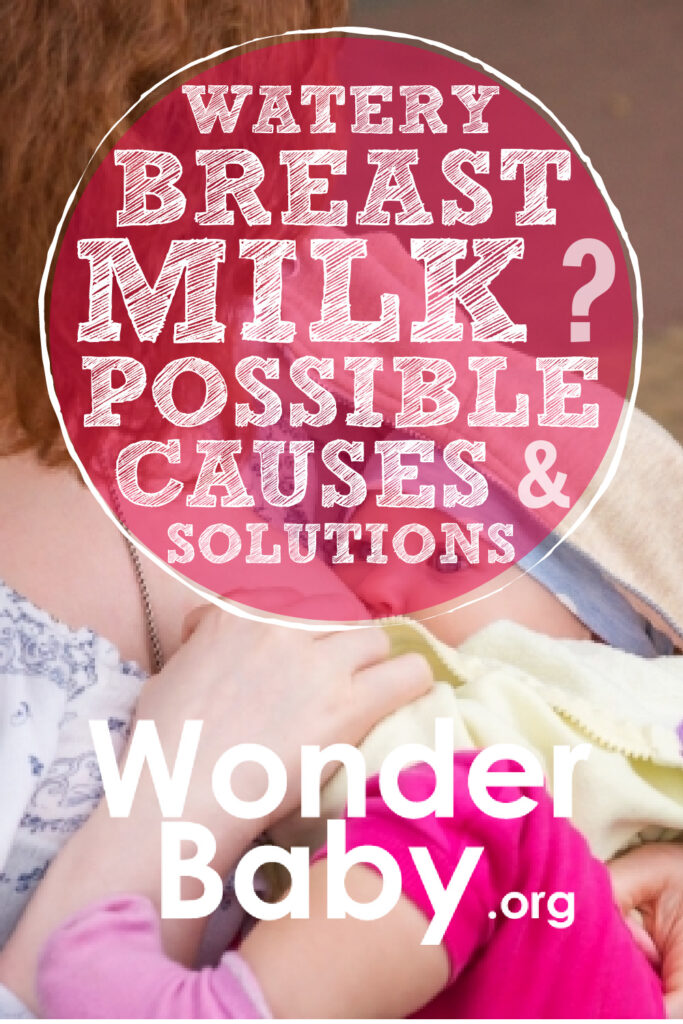Watery Breast Milk? 4 Possible Causes (& Solutions)

- Watery breast milk is normal and usually not something to worry about.
- Some babies will have a foremilk hindmilk imbalance that can make them sick.
- Too much watery foremilk is usually corrected by completely emptying the breasts.
Breastfeeding moms rely on signs like wet diapers and baby’s weight gain to know whether their baby is getting enough milk. Volume of breast milk, however, is not the only thing moms worry about. Many breastfeeding mothers worry about watery milk as well. The good news is: watery breast milk is rarely a serious problem.
Usually, your breasts produce the perfect combination of breast milk for your baby. Most moms don’t have to worry about calories in their breastmilk or if their milk has enough fat. If you’re worried about your baby having trouble gaining weight or trouble digesting, it’s possible that watery milk is the cause. If you’re worried about watery milk, these 4 possible causes and solutions can help.
How Do You Know if You Have Watery Breast Milk?
If you’re breastfeeding, it might be difficult to tell if you have more watery or creamier milk. Babies’ overall growth and color of their stool are the best indicators of a breast milk problems. If you’re concerned about green stools or weight gain, you should consult your healthcare provider.
Using a combination of pumping and breastfeeding can give you an idea of the fat content of your milk supply. As your pumped breast milk sits in the refrigerator, higher fat milk will float to the top. It is perfectly normal for breastmilk to have a thin layer of high fat milk at the top with a lot of clearer milk at the bottom.

Understanding Foremilk and Hindmilk
The difference between hindmilk and foremilk
Every mom produces more watery foremilk and higher fat hindmilk. Foremilk and hindmilk are not two distinct types of milk that your body makes. Your breasts store the low fat milk near the nipple and front of the breast, and the creamier milk near the back.
Foremilk is the part of milk stored near the front of the breast. This is the first milk your baby will drink when they start nursing. It’s also what will come out first when you’re pumping. Foremilk is mostly water and is rich in lactose. Lactose molecules are milk sugars. Just because this part of the milk is watery doesn’t mean it is not important. Foremilk is full of nutrients and calories that your baby needs.
As your breast empties, the breast milk changes to a higher fat content. The fatty milk that is expressed toward the end of a feeding is called hindmilk.
Foremilk and hindmilk imbalance
Foremilk and hindmilk imbalance occurs when a baby drinks too much foremilk. The baby fills up before getting any hindmilk. This leads to lactose overload. Foremilk hindmilk imbalance doesn’t mean that you need more fat in your milk. It just means that your baby is not emptying your breasts and getting to the hindmilk.
Lactose overload
Lactose overload becomes a problem when a baby gets too much lactose-rich foremilk. Lactose can be hard on your baby’s digestive system if they get too much of it. When a baby drinks large volumes of foremilk, they get all the lactose and less of the fat. The lack of fatty milk isn’t the problem, it’s the milk sugars.
Signs of lactose overload in breastfeeding babies
Lactose overload, while rare, can make your baby pretty uncomfortable. Signs of lactose overload are similar to many other digestive disorders. Undigested lactose in your baby’s system will cause gas, stomach cramping, and green, frothy stool. Your baby may be fussier than normal and have explosive bowel movements or diaper blowouts several times a day. A baby with lactose overload may react like a person with lactose intolerance after eating dairy products.
What Causes Watery Breast Milk?
1. Switching sides before emptying the breast
If you switch sides before one breast is empty, your baby will not get hindmilk from the first breast. They also may get full before finishing on the second side. This means they would only get foremilk from each breast.
2. Short pumping sessions
Pumping works similarly to breastfeeding. Foremilk comes out first, and hindmilk comes out last. A quick pumping session will relieve pressure, but won’t produce hindmilk. Stopping pumping before your hindmilk is expressed makes breast milk watery.
3. Long periods of time between nursing
As you go longer between nursing sessions, your breasts will continue to fill. If they fill beyond what your baby can drink in one session, your baby will get full and stop feeding before they get any hindmilk.
4. Overproduction of breast milk
If you are a mother struggling to make enough milk, you might feel envious of moms dealing with an overproduction of breast milk. However, overproduction can cause its own set of problems. Overproduction means that the breasts fill more quickly, making it harder to completely empty them.

Is Watery Breast Milk Safe for Babies?
Watery milk is completely safe for babies. In fact, it is very important for babies to get enough watery foremilk. Foremilk contains mostly water and lactose. Lactose supports your baby’s development and gives them energy.
Helpful Tips to Make Breast Milk Less Watery
1. Let your baby stay on one breast
La Leche League International states that it’s best to let your baby decide when they’re finished eating. Keeping your baby on one breast for as long as they’ll eat ensures that they will get enough fat at the end. Getting a deeper latch can also help your baby with breastfeeding effectively.
2. Add a few minutes to your pumping session
While pumping, try not to cut your session short. Make sure that your breast is completely empty before removing your breast pump. If your pumped breastmilk looks completely blueish or clear, try to keep pumping for a few minutes to get more hindmilk.
3. Increase frequency of breastfeeding sessions
As the breast fills with milk, more water builds up in the front of the breast. Even though more fatty milk is also made, it sticks to the tissue toward the chest wall. Breastfeeding or pumping more frequently will give the breasts less time to fill. Less full breasts release hindmilk more quickly.
4. Correct overproduction
A lactation consultant helps mothers figure out why they are overproducing. They can also help you come up with solutions. Making more milk than your baby needs is fine for building up storage. But if your baby cannot keep up with what your body makes, it can cause problems.
FAQs
Does pumping impact how watery breast milk is?
Pumping does not impact how watery breast milk is, unless you pump so much that your body overproduces. Breast milk does not contain any different components when it is pumped.
What are the different colors of breast milk and their characteristics?
Breast milk might be yellow, white, cream, green, blue, or clear. The foods you eat may impact the color of your breast milk. Frozen breast milk usually turns yellow. Breast milk may turn pink when blood from mastitis gets into the milk.
Is there a connection between a mother’s diet and the characteristics of her breast milk?
Human milk is generally 87% water, 7% lactose, 4% fat, and 1% protein. Foods a mother eats can impact the color, but the composition of the milk doesn’t change much from person to person. Even malnourished mothers have roughly the same composition of breast milk.
Many small nutrients pass from a mother to her breastfed baby. Medicines and drugs are also passed through breast milk. Moms should eat a healthy diet high in protein to keep themselves and their babies healthy.

The information WonderBaby provides is not intended to be, and does not constitute, medical or other health advice or diagnosis and should not be used as such. Always consult with a qualified medical professional about your specific circumstances.
Related Posts

Breastfeeding, Sleep
Sleep and Breastfeeding: A Comprehensive Guide for Nursing Moms
Many people assume breastfeeding and sleep training don’t go together, but it is possible to help your baby sleep better while continuing your breastfeeding journey.

Breastfeeding
Comfort Nursing: Pros, Cons, and How to Stop
Find out what comfort nursing is, when should you worry about it, and how to stop or limit your baby's comfort nursing (especially at night!).

Breastfeeding, Product Reviews
5 Best Breastfeeding Chairs for Nursing Moms of 2023
Whether you want a gentle rock, a smooth glide, or a cozy cuddle to soothe your baby to sleep, you’ll have your pick of the best breastfeeding chairs on the...